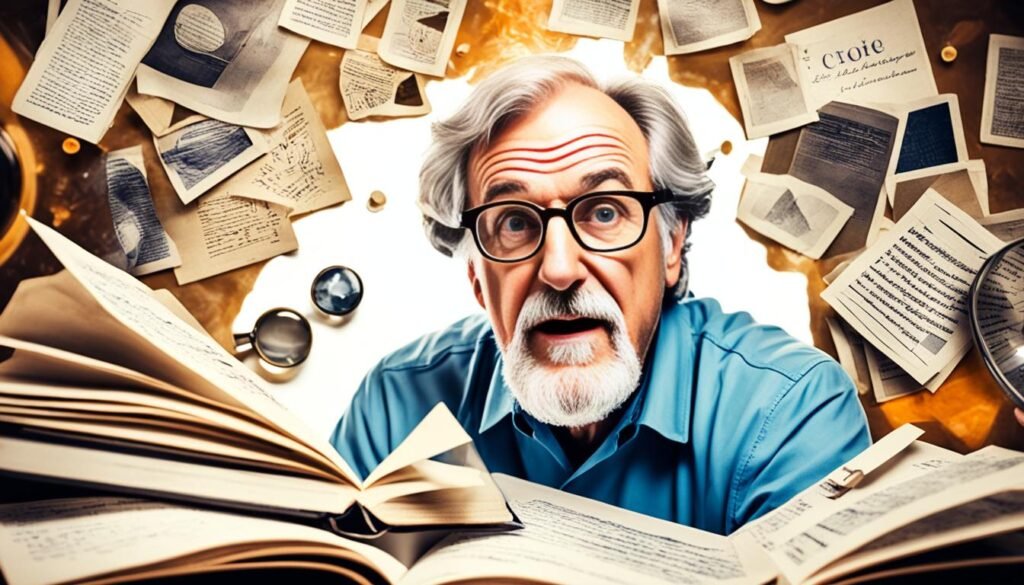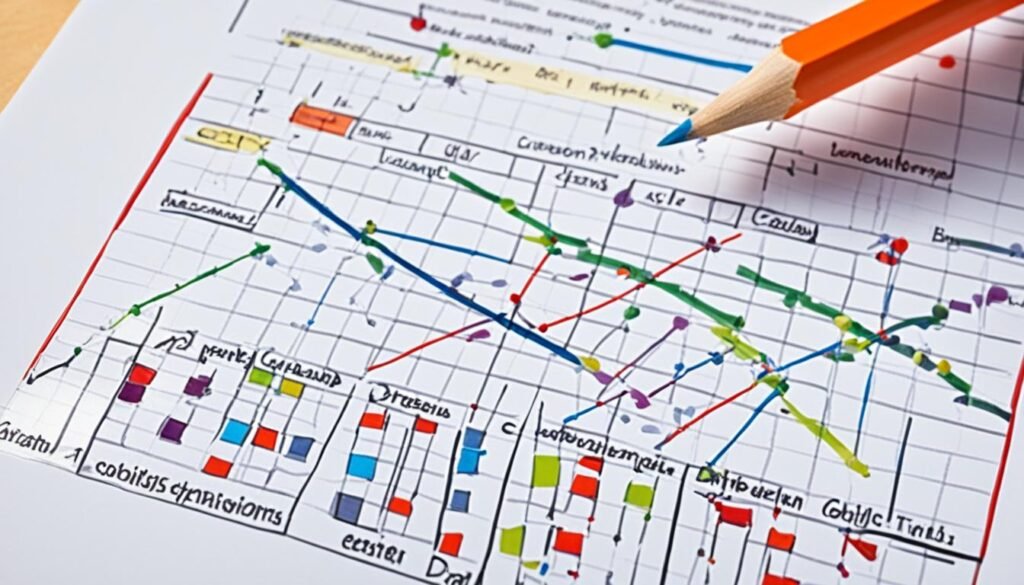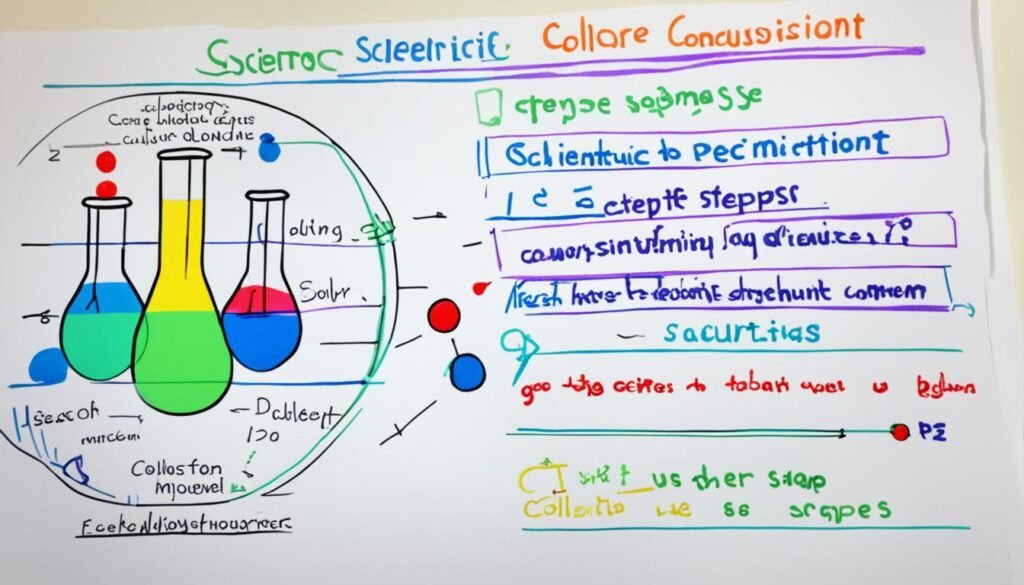Scientific experiments are key to the scientific method. They help scientists explore and find answers about our world. These experiments follow a process with important steps. These steps include asking a question and testing a hypothesis through experiment.
This process also involves analyzing data and coming to conclusions. At the center of all this is the actual experiment. It lets scientists check their ideas and get real proof.
Experiments come in many types, from lab tests to observing things in nature. But they always focus on changing one thing to see what happens. This way, scientists can find out why something happens.
Starting an experiment means creating a clear question. Then, you make a plan, gather evidence, and study what you’ve found. Finally, you use this information to see if your idea is right.
Doing experiments helps us learn more about the world. Through careful work, scientists uncover the secrets of nature. These discoveries help us all understand the world better.
Key Takeaways – Scientific Experiments
- Scientific experiments are a crucial part of the scientific method, which is the process used by scientists to explore observations and answer questions about the natural world.
- Experiments can take many forms, from controlled laboratory studies to natural field observations, but they all involve systematically manipulating variables to determine cause-and-effect relationships.
- The basic steps of a scientific experiment include formulating a clear, testable question, designing an experimental procedure, collecting and analyzing data, and interpreting the findings to reach a conclusion about the hypothesis.
- Scientific experiments are essential for advancing scientific knowledge and understanding the natural world by providing empirical evidence to test hypotheses and theories.
- The process of conducting a scientific experiment is an iterative one, as scientists may need to revise their hypotheses and repeat experiments to fully understand a phenomenon.
Understanding the Scientific Method
The scientific method is how scientists explore the world. It helps them test ideas and gather facts. This method is key for anyone doing experiments. It leads to new scientific discoveries.
What is the Scientific Method?
It’s a way to look at the world and ask questions. The scientific method uses steps like making guesses, testing those guesses with experiments, and then checking the results. This helps scientists find out how things work experimental science kids will be amazed carbon dioxide make predictions make predictions principles of science independent and dependent variables.
Steps of the Scientific Method
- Ask a Question: Start by noticing something interesting. This will be the basis for your research.
- Conduct Background Research: Then, learn as much as you can about your topic. Read what others have found and see what questions remain.
- Develop a Hypothesis: Next, make an educated guess. This guess will be tested during your experiment.
- Design an Experiment: Now, plan how to test your guess. Think about the main variables and groups involved.
- Collect and Analyze Data: Carry out your experiment and collect data. Then see if your results back up your guess.
- Draw Conclusions: After looking at your results, decide if your guess is right. Discuss what this means for science.
- Communicate Results: Lastly, tell others about what you found. Share your work through reports or talks.
Different sciences may use the scientific method in their unique ways. But, these steps always help scientists learn more about the world.
| Step | Description |
|---|---|
| Ask a Question | Identify something that makes you curious. This will be the start of your scientific journey. |
| Conduct Background Research | Read up on what’s already known. This fills in gaps and spots new questions to ask. |
| Develop a Hypothesis | Make an educated guess. It predicts what you think your experiment will show. |
| Design an Experiment | Create a test to check your guess. Choose what to measure and who takes part. |
| Collect and Analyze Data | Do your test and get information. Then, see what the info tells you. |
| Draw Conclusions | Figure out if your guess was right. Discuss what your findings mean. |
| Communicate Results | Share your discoveries. Tell others what you learned and how you did it. |
The scientific method helps us explore and understand nature systematically. By using it, scientists make sure their work is solid and moves science forward. This method is at the heart of many great scientific breakthroughs.
Asking a Question
Right at the start of the scientific method is asking the right questions. A experiment gets going with a question that can be tested about something in nature. This question sets the path for all the steps in the scientific method conduct an experiment outcome of the nature of scientific changed in the experiment treatment group hands-on experience and science achievement kids to create a paper fields of science.
It’s very important to word the question clearly. This helps shape how the scientific investigation goes. Good questions are clear, focused, and stir a real interest in the world. Scientists begin with wider questions and then make them more precise to focus their study.
Let’s take the example of a big question, like “Does the environment change how plants grow?” A more focused, testable question could be “How does soil pH affect how fast tomato plants grow?” By setting the variables, like the soil’s pH and the plant growth speed, a clear experiment can be made. This experiment can then give real answers.
Asking the right questions is key to making good experiments and to learning more about science. It needs close observation, thinking carefully, and being really curious about our world. Good questions can lead scientists to find new facts. They help us understand science better.
“The important thing is not to stop questioning. Curiosity has its own reason for existing.” – Albert Einstein
Conducting Background Research

First, after you’ve created a research question, dive into background research. This means looking into what’s already out there on your topic. You’ll check out scientific journals, textbooks, and more to understand the current knowledge.
Finding Information Sources
The main goal now is to find out the knowns and unknowns in your question. By looking at different sources like journals and speaking to experts, you get a full view. This helps lay a solid foundation for your own experiment.
- Scientific journals and publications
- Textbooks and academic literature
- Online databases and research repositories
- Interviews with experts in the field
Writing a Research Plan
Along with gathering info, scientists will make a research plan. This plan details everything from data collection to the approach and timing. A good research plan is key. It means your experiment builds on what’s already known and has a chance to find something new.
Doing thorough research and planning is vital in the scientific method. It gives your experiment the right starting point and structure to succeed. By knowing the existing knowledge and planning carefully, you’re more likely to add something important to your field.
Constructing a Hypothesis
In the scientific method, making a hypothesis is very important. It comes after asking a question and researching. A hypothesis is a smart guess about how things relate that you can check by testing. Making a hypothesis that can be proven right or wrong is key to good experiments.
Variables and Predictions
A good hypothesis will show the independent variable (the one the scientist changes) and the dependent variable (the one they measure). It should also guess what will happen. For example, a hypothesis could say: “If the water’s temperature goes up, the evaporation rate will go up too.”
In this example, heating the water is the independent variable, evaporation rate is the dependent variable, and the guess is that making the water hotter will make it evaporate faster. Clearly stating the variables and the guess is vital for a strong hypothesis.
A hypothesis forms the basis for an experiment. It tests if the guess between the variables is right or wrong. A clear hypothesis guides the experiment’s design and helps scientists interpret their findings.
| Example Hypothesis | Independent Variable | Dependent Variable | Prediction |
|---|---|---|---|
| If the temperature of the water is increased, then the rate of evaporation will increase. | Water temperature | Rate of evaporation | Increasing the temperature will lead to a higher rate of evaporation. |
| If the amount of fertilizer used on a plant is increased, then the plant’s growth rate will increase. | Amount of fertilizer | Plant growth rate | Increasing the amount of fertilizer will lead to a higher plant growth rate. |
| If the frequency of exercise is increased, then the resting heart rate will decrease. | Exercise frequency | Resting heart rate | Increasing the exercise frequency will lead to a lower resting heart rate. |
By creating a hypothesis that identifies the variables and predicts the outcome, scientists prepare for a valuable experiment. This experiment can deepen our understanding and push science forward.
Testing the Hypothesis: Experimentation
The scientific method starts with experimentation. Once a hypothesis is formed, scientists set up tests. These experiments check if their predictions are correct. It’s a key part in learning new things.
Designing the Experiment
To get reliable results, a strong experimental plan is crucial. Scientists must clearly define what they’re changing and what they’re measuring. This isolates the key relationship they are studying. Also, they match up a control group with the experimental group to keep their test fair.
Experiments are better when they follow a set plan. This plan lists what’s needed, how things will be done, and how information will be collected. Such careful planning ensures the experiment is fair and produces valuable data.
Conducting the Experiment
Next, scientists get their hands dirty and start the experiment. They keep to the plan, take notes, and gather data on the dependent variable. It’s important to follow the steps exactly to avoid mistakes and bias.
During the experiment, scientists watch the changing variable closely. They note any unexpected events and record what happens. This careful record-keeping is crucial for analyzing the data later.
By being both careful in design and rigorous in execution, the experiment is the first step of the bigger scientific process. This is where data is examined and conclusions are made about the hypothesis.
Scientific Experiment: Data Analysis

After finishing the scientific experiment, we must dive into the collected data. We work on setting up the information in charts, graphs, or visuals. The goal is to spot any patterns or important points. Then, we use math techniques, like figuring out the means and more, to check how solid our results are.
Organizing and Analyzing Data
The big aim of digging into the data is to check if our tests support or go against the early guess. This check is key in the scientific method. It lets us find out if there’s a real link between the things we are testing. From looking at the data closely, scientists can learn new and key things.
Here’s how the data analysis works:
- Ordering the data neatly in tables or spreadsheets comes first. This helps make sure everything is accurate.
- Later, we make things visual with graphs or charts. This step makes the data patterns easier to see.
- Then we do some math. Things like figuring out averages, medians, and their spread tell us if we found something real.
- It’s also a must to look for errors or other things that could mess up our findings.
- Last but not least, we interpret the data analysis. This gives us clear answers about what we were testing.
By thoroughly looking into the data, we really get what the experiment came up with. This helps push scientific knowledge forward. Plus, it sets the scene for more experiments and scientific investigations to follow.
| Statistical Analysis Technique | Description | Purpose |
|---|---|---|
| Mean | The average value of the data set | Measure of central tendency |
| Standard Deviation | A measure of the spread or variability of the data | Measure of dispersion |
| Correlation | A measure of the strength and direction of the relationship between two variables | Determine the relationship between variables |
Drawing Conclusions

After the experiment, scientists must look at their data and draw conclusions. It’s a crucial step. They see if the results back up the guess they first made.
If the results fit what they thought would happen, it’s a win for the idea. This means their explanation about the topic is likely correct. It also adds to what we know in science.
If the results don’t match their first guess, more work is needed. They might need to change what they guessed for their next steps. Always learning something new, their work can help spark fresh ideas and more research.
Coming to clear, fact-based answers is key for scientists. It helps them build on what they found. This can push the subject area ahead, even if it means changing or dropping the initial idea.
“The ultimate goal of the scientific method is to produce explanatory hypotheses that are supported by empirical evidence, both through direct observation of natural phenomena and through experimentation.” – Encyclopædia Britannica
After studying their data closely, scientists can make big steps in what we know. This effort is all about finding more answers and ideas for future research.
Communicating Results
The last step in a experiment is sharing results with other scientists. This is key. To do this, scientists create a detailed final report and may show their work at conferences or in journals.
Final Report and Presentation
The final report is a detailed record of a scientific investigation. It includes the research’s start, the hypothesis, how the experiment was set up, the data looked at, and what was finally found. This report lets others in the field know what was discovered and how it was done. It helps them either confirm or find new paths to explore.
Aside from the report, scientists can also talk about their work at scientific conferences. These events let them share with fellow experts, get their feedback, and add to the wide scientific conversation. This kind of communication is crucial for the growth of what we know and how we understand the world through science.
Whether through writing or speaking, being clear is vital. Explaining the main points and what they mean is key. By doing this, scientists help move our knowledge forward. They are vital to the ongoing testing of theories and exploring new ideas in science.
Both the report and the presentation should follow strict research methodology and data analysis. They should present results in an informative and appealing way. This makes sure that new scientific knowledge is shared well. And it helps science keep progressing by building on what was discovered.
Also Read: What Are The Biggest Challenges In Scientific Research?
Conclusion
The scientific experiment is crucial for the scientific method. It’s a structured way for researchers to explore our world. This process lets us gather knowledge through carefully planned experiments three main types experiment example science teaching.
Researchers follow several important steps during an experiment. They start by asking a smart question and doing lots of research. Then, they create a hypothesis that can be tested.
After that, an experiment is designed and carried out. They then look at the data they’ve collected. This helps them draw accurate conclusions and share their findings with others.
By sticking to this method, scientists learn more about their topics. They also help advance their fields. This method is key to deepening our knowledge of various sciences. It helps in areas such as biology, physics, psychology, and studying the environment.
As scientists develop new ways to do experiments, our understanding grows. This ongoing effort propels us to discover more about our world. With the scientific method, the search for knowledge is never-ending.
FAQs
Q: What is a science experiment?
A: A science experiment is a procedure carried out to support, refute, or validate a hypothesis.
Q: What is a controlled experiment?
A: A controlled experiment is a type of scientific experiment where all variables are kept constant except for the one being tested.
Q: What are the basic steps of a scientific experiment?
A: The basic steps of a scientific experiment include forming a hypothesis, designing the experiment, collecting data, analyzing the results, and drawing conclusions.
Q: Can you give an example of a scientific experiment?
A: An example of a scientific experiment could be testing the effects of different fertilizers on plant growth in a controlled setting.
Q: What are the different types of experiments?
A: The different types of experiments include randomized experiments, field experiments, laboratory experiments, and natural experiments.
Q: Why is replication important in experiments?
A: Replication is important in experiments to ensure the reliability and validity of the results obtained.
Q: What is the significance of a well-designed experiment?
A: A well-designed experiment helps in minimizing bias, ensuring accuracy, and increasing the credibility of the results.
Source Links
- https://www.amnh.org/explore/videos/the-scientific-process
- https://www.sciencebuddies.org/science-fair-projects/science-fair/steps-of-the-scientific-method
- https://www.khanacademy.org/science/biology/intro-to-biology/science-of-biology/a/the-science-of-biology

